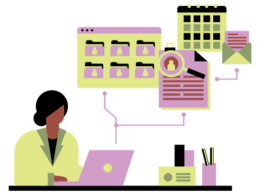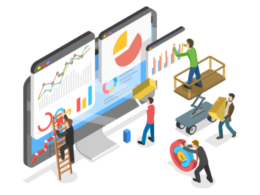In today’s whirlwind of a business world, HR professionals don’t just face challenges; they face an ever-accelerating tornado of change. And at the heart of their stormy responsibilities lies the critical art of decision-making.
Picture this: every decision they make has a ripple effect that can either propel an organization to meteoric success or leave it stranded in the doldrums of mediocrity.
But here’s where the plot thickens and the excitement surges: real-time data has emerged as the superhero of HR decision-making! It’s not just a lifeline; it’s a game-changer that’s reshaping the very fabric of HR practices. It empowers HR professionals with the ability to make informed decisions at the speed of thought.
In this electrifying blog, we’re about to embark on a journey that will reveal the superheroic ways in which real-time data swoops into rescue HR decision-making, propelling us into an era of smarter workforce management.
- How do HR professionals navigate the turbulent waters of decision-making in today’s fast-paced business world?
- Can real-time data truly be the cape-wearing hero HR needs to revolutionize its practices?
- What happens when HR decisions are made without real-time data, and how does this impact organizations?
- What are the real-life stories of organizations that have harnessed the power of real-time data in their HR decisions?
- How does real-time data impact the way HR professionals recruit and acquire top talent?
- What role does real-time data play in boosting employee engagement and retention?
- How does real-time data redefine the traditional annual performance review?
- What strategies can HR employ to use real-time data for customized training and development programs?
- How does real-time data help HR departments stay compliant with labor laws and mitigate risks?
- What are the potential consequences of ignoring the real-time data revolution in HR decision-making?
Hold on tight; we’re about to dive into the exhilarating world of HR superpowers!

Let’s delve deeper into each of the areas where real-time data enhances HR decision-making:
A. Enhanced Recruitment and Talent Acquisition
Recruitment is often a race against time to secure the best talent before competitors do. Real-time data tools enable HR professionals to gain a competitive edge by tracking various aspects of the recruitment process in real-time.
Here’s how:
1. Job Openings Tracking
Real-time data analytics tools provide HR teams with a dashboard where they can monitor the status of job openings. This includes details such as the number of open positions, their respective locations, and the roles associated with them. This real-time visibility ensures that no job posting goes unnoticed and that positions are filled promptly.
2. Candidate Applications
HR professionals can track candidate applications as they flood in. With real-time insights, they can see which job postings are attracting the most applications and which may need additional promotion. This data-driven approach enables HR to allocate resources more effectively and target their efforts where they will yield the best results.
3. Progress Monitoring
The progress of ongoing recruitment efforts, such as interview stages and candidate assessments, can be monitored in real-time. This allows HR to identify bottlenecks in the process and take immediate corrective action. For instance, if interviews are consistently delayed at a particular stage, HR can intervene and streamline the process, ensuring a faster turnaround.
4. Adaptation to Market Trends
Real-time data also empowers HR teams to adapt to ever-changing market trends. If data reveals a surge in demand for a specific skill set, HR can swiftly adjust their recruitment strategies to target candidates with those skills. This adaptability ensures that the organization remains agile and can quickly respond to the evolving needs of the job market.
B. Employee Engagement and Retention
Employee engagement and retention are vital for building a motivated and loyal workforce. Real-time data tools facilitate these aspects in the following ways:
1. Survey and Feedback Analysis
HR can use real-time data to analyze employee surveys and feedback as they are collected. This immediate feedback loop allows HR to pinpoint areas where employee satisfaction is high and where improvements are needed. Timely action in response to employee feedback fosters a positive workplace culture and boosts morale.
2. Performance Metrics
Real-time data helps HR track performance metrics continuously. For example, productivity metrics like project completion rates or sales targets can be monitored in real-time. Managers can identify and recognize outstanding performance as it occurs, providing employees with timely feedback and motivation to excel.
3. Trend Identification
By analyzing real-time data on employee turnover, HR can identify trends and patterns. For instance, if data shows that employees tend to leave after a specific tenure, HR can proactively implement retention strategies like career development programs or enhanced benefits just in time to retain top talent.
C. Performance Management and Feedback
Performance management is no longer limited to annual reviews. Real-time data transforms this aspect of HR in the following ways:
1. Continuous Assessment
Instead of waiting for annual or semi-annual reviews, HR can use real-time data to continuously assess employee performance. Regular check-ins can be based on data-driven insights, enabling managers to offer immediate feedback and support for areas needing improvement.
2. Individual Development
Real-time data helps tailor development plans to individual employee needs. HR can identify strengths and weaknesses in real-time and recommend training or mentorship programs accordingly. This personalized approach to development ensures that employees receive the most relevant and effective training for their growth.

D. Training and Development
HR’s role in employee training and development becomes more effective with real-time data.
1. Progress Tracking
Real-time data allows HR to track the progress of employees in training programs. This includes course completion rates, test scores, and feedback. HR can intervene promptly if employees face difficulties, ensuring that everyone receives the support needed for successful development.
2. Skills Gap Analysis
By constantly monitoring employee skills and performance, HR can identify emerging skill gaps within the organization. This awareness enables HR to proactively address these gaps through training and development programs, reducing the risk of skills shortages that could hinder business operations.
E. Compliance and Risk Management
Staying compliant with labor laws and managing risks are essential for any organization. Real-time data is a valuable asset in this context:
1. Up-to-the-Minute Insights
Real-time data provides up-to-the-minute insights into HR processes, such as time and attendance records. It ensures that organizations remain compliant with labor laws and regulations by highlighting any potential compliance issues as they arise.
2. Risk Mitigation
Real-time data helps HR identify and mitigate risks related to HR practices. Whether it’s addressing workplace safety concerns, preventing harassment, or managing employee disputes, real-time data enables HR to act swiftly and decisively. This proactive approach reduces legal and reputational risks, safeguarding the organization’s interests.
In the digital age, real-time data has become an indispensable tool for HR professionals. Its ability to provide immediate insights into various aspects of workforce management, from recruitment to compliance, empowers HR decision-makers to make informed choices that positively impact the organization.
By harnessing the power of real-time data, HR departments can enhance recruitment efforts, boost employee engagement and retention, improve performance management, and ensure compliance with labor laws. In a competitive business environment, the integration of real-time data into HR decision-making processes is no longer optional—it’s a strategic imperative for success.
Ready to embark on an exciting career in HR analytics? Join Accredian’s Executive Program in Strategic HR Analytics today and become a leader in this dynamic field.
 Pin
PinYour journey to data-driven HR excellence starts here. Click to enroll now!






